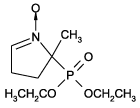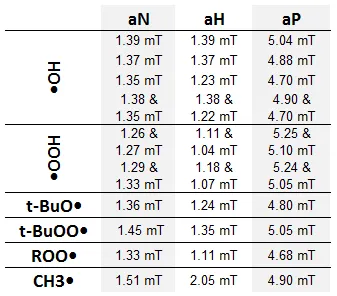Recently we purchased 2-(5,5-Dimethyl-2-oxo-2λ5-[1,3,2]dioxaphosphinan-2-yl)-2-methyl-3,4-dihydro-2H-pyrrole 1-oxide, 5-(2,2-Dimethyl-1,3-propoxy cyclophosphoryl)-5-methyl-1-pyrroline N-oxide, a lovely spin trap made by Sigma-Aldrich. For practical reasons, it's called CYPMPO.
My task is to find the parameters for CYPMPO spectra so we could identify them properly. I could write it down in Word, but steemstem.io is way cooler.
Enjoy the mini-review, feb. 2019:

Maybe you can recognize that its structure resembles DEPMPO:

And DEPMPO looks like DMPO:

The advantage could be the ability to use CYPMPO for non-water based samples because the melting point of CYPMPO is 126oC, while the flashing point of DEPMPO is only 109oC.
It's also less toxic than DEPMPO.
Water solubility: DMPO > DEPMPO > POBN > CYPMPO > DBNBS > EMPO > BMPO > MNP > PBN
Spectra are very similar in shape to those formed but DEPMPO, but I need to see what are the values for hyperfine coupling constants, parameters that determine the splittings between the lines.
Let's ask Scholar Google: CYPMPO "hyperfine coupling"
43 results, great, I can become an expert in a few hours, and you in about 10 minutes, when you finish the reading of my post.
If you are wondering why on Earth I don't go to https://tools.niehs.nih.gov/stdb/index.cfm :

It's not listed yet :D
The following paper describes CYPMPO-OH adducts with parameters:
- aN = 1.39 mT
- aH = 1.39 mT
- aP = 5.04 mT
The same paper also stated that CYPMPO-OOH adduct was not observed (very, very strange observation).
Similar parameters were observed in this study (and the next reference):
- aN = 1.37 mT
- aH = 1.37 mT
- aP = 4.88 mT
Review-like paper found:
- aN = 1.35 mT
- aH = 1.23 mT
- aP = 4.70 mT
And HFCC simulation:
- aN = 1.38 & 1.35 mT
- aH = 1.38 & 1.22 mT
- aP = 4.90 & 4.70 mT
Ok... So far so good, aN = aH, don't worry for a couple of G
SuperOxide: (please check this paper, page 4 :) )
- aN = 1.26 & 1.27 mT
- aH = 1.11 & 1.04 mT
- aP = 5.25 & 5.10 mT
HFCC parameters (simulations!!!):
- aN = 1.29 & 1.33 mT
- aH = 1.18 & 1.07 mT
- aP = 5.24 & 5.05 mT
Next paper, parameters for ROO:
- aN = 1.33 mT
- aH = 1.11 mT
- aP = 4.68 mT
More alkoxyl and alcoperoxyl examples:
- t-BuO* aN = 1.36 mT
- aH = 1.24 mT
- aP = 4.80 mT
- t-BuOO* aN = 1.45 mT
- aH = 1.35 mT
- aP = 5.05 mT
This is Lovely!!! Look at this difference, it's a big, easy to read difference!
Old good *CH3:
- aN = 1.51 mT
- aH = 2.05 mT
- aP = 4.90 mT
Happy Valentines Day, enjoy spin-trapping and EPR
